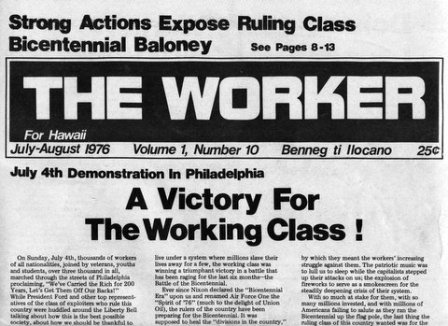
First Published: The Worker, for Hawaii, Vol. 1, No. 10, July-August 1976.
Transcription, Editing and Markup: Paul Saba
Copyright: This work is in the Public Domain under the Creative Commons Common Deed. You can freely copy, distribute and display this work; as well as make derivative and commercial works. Please credit the Encyclopedia of Anti-Revisionism On-Line as your source, include the url to this work, and note any of the transcribers, editors & proofreaders above.
It was quite a hodge podge...A Bicentennial without colonies! End forced sterilization! Vote socialist workers! Down with Apartheid! Ho, ho, homosexual, sodomy laws are ineffectual! Food for people, not for profit! These were among the dozens of chants and banners that came bobbing into the picnic-like atmosphere in Fairmont Park in Philadelphia for the July 4th Coalition Bicentennial demonstration.
Organized mainly by the Puerto Rican Socialist Party and the Prairie Fire Organizing Committee, the public wing of the Weather Underground Organization or Weatherman, the march and rally drew a crowd between 12 and 15,000, including mostly young people and a few workers. Most of those who came had a genuine hatred for some of the crimes of the capitalist system, like the colonial oppression of Puerto Rico, and many had a genuine desire to fight the ruling class. Others came to parade around “causes,” like sexual degeneracy, as if they were something progressive.
The demonstration itself posed no real threat to the rule of the rich. For the most part, groups and individuals saw it as an opportunity to push the particular issues they themselves were concerned about, and this smorgasboard approach was fine with the rally organizers–they were out to push their particular demands. Almost none of the slogans raised pointed to the capitalist ruling class as the common enemy of the great majority of the American people, Instead they called on the system to reform itself–as if war, the drive to exploit small countries, racism and so on could be eliminated without getting the rich off our backs, whose very existence and rule depends on such things.
The basic weakness of this demonstration is clear in the sharp contrast between how the authorities accepted it as a “loyal opposition” to the Bicentennial and the attacks they launched on the Rich Off Our Backs-July 4th Coalition from the beginning. While the city and federal courts did everything possible to prevent the Rich Off Our Backs march, the other was granted permits with minimal difficulties. Both marches had a lot of cops around–along the Rich Off Our Backs route they lined the streets and rooftops in a last ditch attempt to intimidate people from marching. At the other rally in Fairmount Park, they rolled up police water trucks to make sure the crowd was comfortable.
Afterwards the other rally was cheerfully summed up in the ruling class’ news media, like the Chicago Tribune, which reported, “the exuberant peaceful nature of the protest, however, appeared more as propaganda for America’s free-enterprising, free-talking system, and in that sense was a tribute to the spirit of the Bicentennial.”
Even before the Fourth, the media had paid more attention to the Rich Off Our Backs Coalition, although the PSP and Prairie Fire Organizing Committee led group was predicting a turnout of 70,000 for their march. The Rich Off Our Backs-July 4th demonstration was something new to the high and mighty and their press nervously reported on the workers taking part in it, the discipline and determination of the Coalition members, the three militant slogans that aimed the demonstration straight at the ruling class. The same July 5 Chicago Tribune article that embraced the other march fretted that the Rich Off Our Backs demonstration had been “a portent of the type of confrontations that may await Americans [meaning the rich] in the country’s third century.”
The two demonstrations on July 4th show one thing crystal clear. While the thousand and one abuses the capitalists heap on the people every day constantly breed anger and resistance, only the growing workers movement can bring together and focus these battles into a powerful storm of struggle against the rich who plan to ride us for another 200 years.